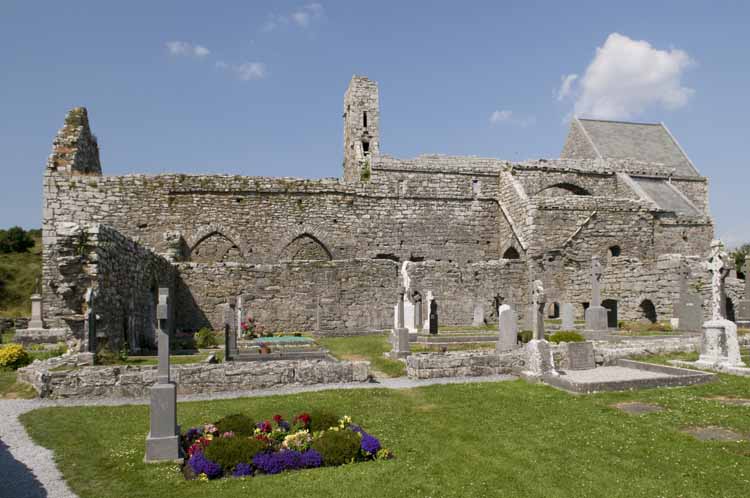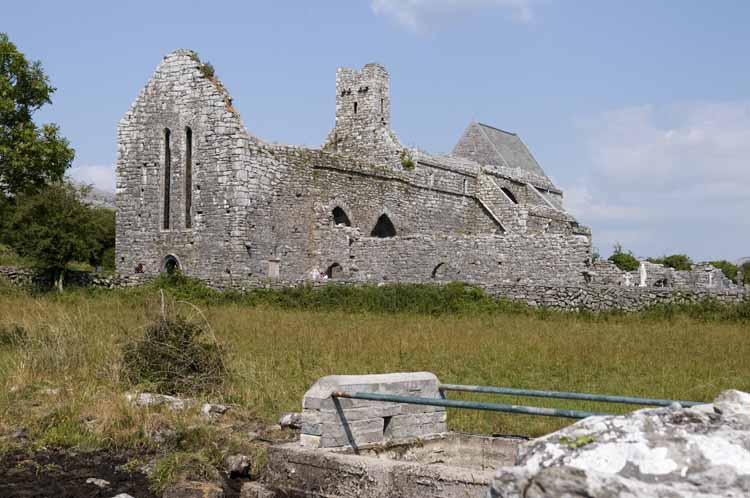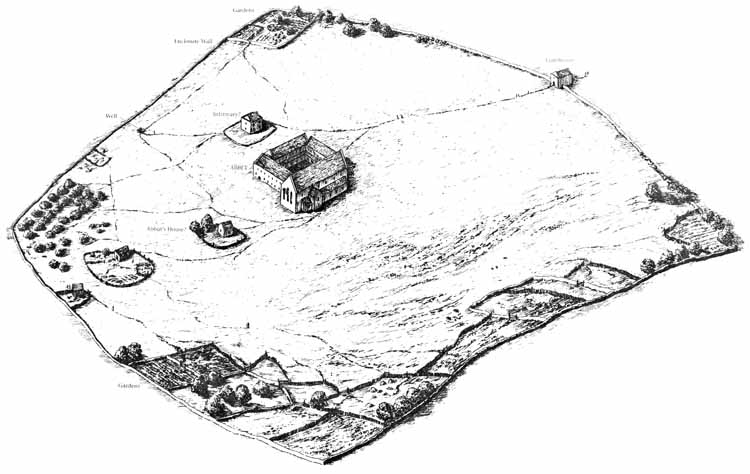The Cistercian Abbey of Corcomroe, County Galway, Ireland,
was founded between 1194 and 1195. The founder cannot be verified but is
thought to be either Donal Mor O’Brien, king of Limerick, or his son Donough
Cairbreach. The abbey was situated amidst the mountains of the Burren, and
its Latin name was inspired by the local environment: ‘Sancta Maria de Petra Fertili’, St. Mary of the fertile rock. Despite the name, cultivation of the
land can never have been easy; Corcomroe was one of the few Cistercian
houses to be founded on the poorer soils of the west of Ireland. The abbey
was surrounded by the bleak limestone hills of northern Clare, the land
devoid of vegetation. Even so, the monastic community must have expanded in
its early years; in 1198 a group of monks was sent out from Corcomroe to
colonise a new abbey at Kilshane, County Limerick. However, it seems that
two or three decades passed before the construction of the permanent
buildings was commenced. As a result of the ‘conspiracy of Mellifont’
(1216-1228) Stephen of Lexington transferred Corcomroe’s affiliation to
Furness, but in 1231 the monks refused to receive visitors sent from this
abbey. In 1267 Conor na Siudaine, the son of Donough Cairbreach, was killed
in battle by his enemy Carrach O’Loughlin. His body was buried in Corcomroe
abbey and a tomb was raised over his grave by the monks. In 1277, 1280 and
1282 there were complaints that the abbot of Corcomroe had not attended the
General Chapter for a long time. This is not, perhaps, surprising, given
that it might take up to three or four months to make the return journey
from Corcomroe to Citeaux. In 1417 the abbey was so poor the monks could not
be properly maintained, and one of the monks was granted leave to serve a
local vicarage. Following the Dissolution, the abbey passed into the hands of the
local lords and the Crown was scarcely involved in this process. In
1554, the abbey was granted to Murrough O’Brien, earl of Limerick; the
site thus reverted to the same family who gave the original endowment. A
revival of the Cistercian Order occurred early in the seventeenth
century, led by Luke Archer, abbot of Holycross. His followers were
appointed as abbots to a number of dissolved Irish houses: in 1628 John
O’Dei, a monk of the college at Salamanca, was appointed abbot of
Corcomroe, even Plan of the Abbey:


The abbey is located in the Burren [derived from Gaelic meaning 'stoney place'], in Southern Galway, covers 160 square km and it is unique, if somewhat bleak and exposed, place with little pasture land and huge pavements of limestone. Most of the drainage, and rivers, are underground and although it is visually bleak it has been occupied from the stone age with evidence of habitation and tomb, including massive dolmens, wedge tombs and stone forts called cahers, in many parts of the area. The Burren is famous for its plant life - mainly those that enjoy rock microclimates such as those also found in Arctic, Alpine and Mediterranean regions. The abbey's backdrop is spectacular and must like a moonscape with some area suitable for pasture and grazing. The monks who settled here must have though that they had truely found a site 'far from the concourse of man' but, in true Cistercian form, they were able to survive by selecting a site which had the capability to support them - the Latin name of the abbey is Petra Fertilis [Fertile Rock]. As there is no stream beside the monastery, its water supply probably came from local springs or a well. The site was colonised from Inislounaght in 1194/5 and the founder was either Donal Mor O'Brien, king of Thomond, or his son Donough Cairbreach.
The church dates from 1210 to 1225, and was planned as a reduced version of the normal Cistercian scheme, with only one chapel opening off each transept. There is an aisled nave, though the roughly built arches are not arranged symmetrically north and south and there is some doubt about whether a north aisle was ever built. The east end of the building is distinguished by the high quality of its stonework-carved capitals, decorated bases, chevron and other ornament-much of it characteristic of the `school of the west'. The presbytery is rib-vaulted in two bays. Before work progressed beyond the transepts a serious deterioration in quality occurred, perhaps due to the famines of 1227-8. In the later middle ages the church was shortened by an intrusive wall, surmounted by a bell turret, and at the same time the roofs and upper walls were extensively remodelled. Fragmentary buildings survive in the east range and there are a number of ruins in the outer precincts, including the remains of a gatehouse. Inside the church is a fine sedile [plural of sedilia], together with the effigy of king Conor na Suidane O'Brien (d. 1267), grandson of the founder. Corcomroe is the only Irish abbey where some preparatory drawings survive: they are to be found incised on a surface of plaster on two walls within the church.
The community was small and in the later middle ages extremely poor. Although a titular abbot is named in 1628, the house had long ceased to exist as a monastic entity. In 1554 the abbey was granted to Murrough O'Brien, earl of Thomond (who was of the same family who gave the original endowment). In 1542, under the Crown of Ireland Act, king Henry VIII was created King of Ireland by the Irish Parliament. So all of the reigning monarchs in Ireland were ordered to surrender their native titles in return for peerages - which was conditional on them adopting Tudor customs and laws including pledging allegiance to the Irish Crown, and the acceptance of the articles and leadership of the new Anglican Church. The 1st earldom of Thomond was created in 1543 and O'Brien was also created Baron Inchiquin in 1543.
One of the information boards at the abbey has the following as a suggest layout of the enclosure although it clearly has many buildings missing and is based on the extant remains :
Sources:
University of Sheffield - The Cistercians in Yorkshire
Project.
Stalley, R. 1987. The Cistercian Monasteries of Ireland, London: Yale
University Press.
Corcomroe Abbey -
http://www.clarelibrary.ie/eolas/coclare/history/autumnal_rambles/corcumroe_abbey.htm

